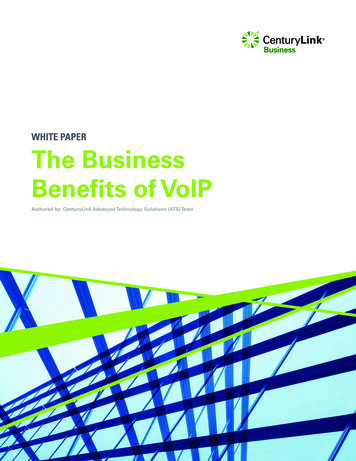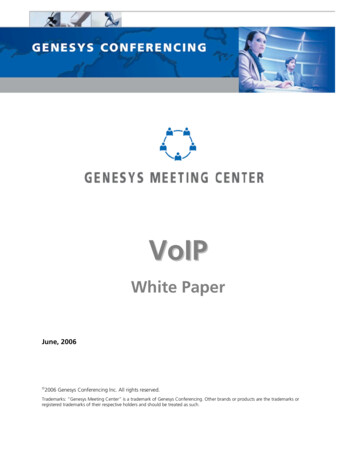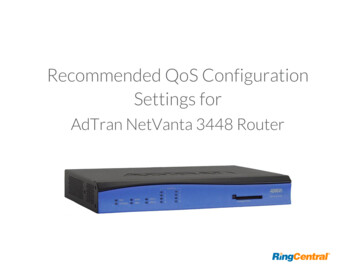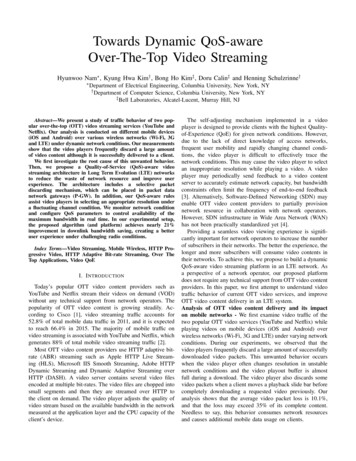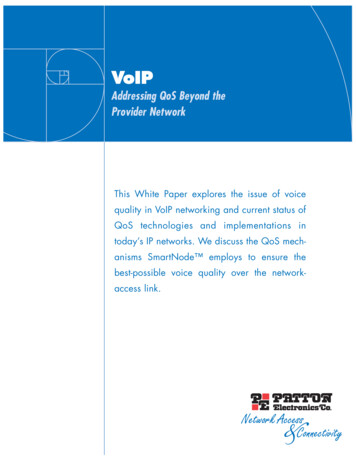
Transcription
VoIPAddressing QoS Beyond theProvider NetworkThis White Paper explores the issue of voicequality in VoIP networking and current status ofQoS technologies and implementations intoday’s IP networks. We discuss the QoS mechanisms SmartNode employs to ensure thebest-possible voice quality over the networkaccess link.
CopyrightCopyright 2006, Patton Electronics Company. All rights reserved.Printed in the USA.2
IntroductionToday’s Internet does far more then email and filetransfers. Initially designed for non-real-time (NRT) dataapplications, the Internet has matured far beyond thesetasks. In addition to web browsing, online imaging, andchat rooms, we now expect the Internet to deliver suchreal-time (RT) media as streaming music, video, andInternet phone calls directly to our homes and offices.Presently, Voice-over-Internet Protocol (VoIP) is all thebuzz—but it’s more than just talk. VoIP technology hasmatured. Not only is it the latest hot new Internet application. Today, VoIP has emerged as a reliable technology that is commercially viable, competing (and winning) against traditional phone services in business andconsumer-class markets.As a real-time application, VoIP—also known as packetvoice, packet telephony, or IP telephony—placesincreased demands on the evolving Internet. VoIP usersexpect the Internet to deliver toll-quality voice with thesame clarity as the traditional Public Switched TelephoneNetwork (PSTN). To meet those expectations, theInternet connection must be more than merely reliable, itmust be time-sensitive. Each and every voice packet mustbe delivered without significant delay and with consistenttime intervals between packets.Advanced Quality of Service (QoS) technology is the keyto achieving voice quality that measures up to today’shigh standards. With SmartNode and Patton’s advancedQoS, toll-quality voice on every call is the benchmark.Quality of Service (QoS)—In a successful VoIPdeployment, the perceived voice quality of VoIP callsmust satisfy user expectations. Specifically, voice quality in the VoIP system must compare favorably with thatof a traditional phone call. To ensure VoIP users hearthe best possible voice quality, Patton’s SmartNodeemploys a unique combination of varied QoS mechanisms. Network administrators can tune SmartNode’sQoS for optimal performance in a broad range of networks giving packet voice the clarity and sound quality we expect on every call.QoS and voice qualityFrom a technical perspective good voice qualityinvolves minimizing delays and interruptions (“blips”) inthe communication stream. For voice communicationsover an IP network, packet delays and losses in the VoIPnetwork must be reduced to the levels of establishedbenchmarks. To achieve a level of perceived voice quality that most users find acceptable, end-to-end packetdelay must be reduced to a target of 120ms or less. Inmost IP networks some degree of packet loss may beinevitable. However, for a successful VoIP deployment, wemust reduce packet loss to well below 1%. For Fax-overIP connections, the packet-loss target is especially critical.Packet loss and packet delay may accumulate atmultiple locations within the IP network. Every router,switch and transmission line is a potential culprit for harboring these enemies of voice quality. Technology standards such as TOS or DiffServ are designed to achievethe goal of establishing QoS in each and every node,thus enforcing QoS mechanisms throughout the networkfrom end to end. (These standards will be discussed laterin this paper.) The reality today, however, is an Internetthat does not differentiate between real-time (RT) andnon-real-time (NRT) packets. As a result, VoIP networksrequire alternate methods for ensuring voice quality.3
Addressing QoS at the edge ofthe networkIn VoIP systems that traverse the Internet, thebottleneck typically occurs at the access link—the lowbandwidth connection between the high-speed Internetbackbone (WAN) and the user network (LAN). Both networks typically run at 100 Mbps or above. A typicalaccess link may easily run about 200 times slower thanthe LAN residing in the home or office (say, 512 kbps forexample). Congestion, queuing delay, and queue overflows (resulting in dropped packets) are most likely tooccur on this link. Depending on access-link bandwidth,packet size and burst size (the number of packets arriving at once), queuing delay can be especially significant.In a typical installation, a single access link servesboth voice and data traffic, so special measures mustbe employed to ensure good voice quality. Considerthe case of a 256 kbps access link from the Internet’sedge router to the user’s LAN. Suppose the Internet’stransmit queue contains five 1500-byte data packets,followed by one time-sensitive voice packet. It will takeroughly 270 ms to send those data packets over the256 kbps link. When the voice packet follows, itarrives with a delay longer than 120 ms (our target),resulting in degraded voice quality.Introducing class-of-service in the packet layeraddresses queuing delay by ensuring voice packetsreceive priority treatment—in much the same way thatseparate queues at airport check-in counters ensure priority service to first-class customers. By creating separatequeues for Real-Time and Non-Real-Time traffic, we canassign higher priority to the RT queue and serve that traffic with higher priority.Upstream and downstream traffic present differentproblems, and are best addressed by different Quality ofService (QoS) mechanisms. Upstream traffic flows fromthe (home or office) user to the Internet, while downstream traffic flows from the Internet to the user.Implementing QoS in the upstream direction isrelatively easy. SmartNode ensures that outboundvoice packets get served before other packet types toprevent the Internet access link (the bottleneck) frombecoming overloaded. SmartNode also provides tuning mechanisms for additional parameters like packetsegmentation and overhead optimization, so networkadministrators can further fine-tune the upstream transmission for optimum voice quality.Implementing QoS in the downstream direction is more complex. Typically, customer-premiseequipment (CPE) at user locations exerts no controlFigure 1. Internet Access4
Figure 2. The Problem of Downstream Trafficover incoming traffic. For traffic flowing downstreamfrom the Internet, the access router cannot control thevolume nor the sending users. In addition, local userssharing the LAN with you can initiate file transfers ordownload their email at their convenience. The servershandling these requests may be located anyplace.Since the downstream rate normally cannot be controlled, the ISP’s edge router commonly responds tooverloading by discarding VoIP packets with the sameprobability as any other packet type. These factors, ora combination of them, may degrade voice quality toa degree that users find objectionable. Data traffic, onthe other hand, can be retransmitted so the impact onthe user experience is simpler slower service response.To resolve the problem of degraded voicequality for incoming traffic, Patton has devised a leading-edge technology for SmartNode calledDownStreamQoS . Within the SmartNode deployedat the customer premise, DownStreamQoS dynamicallycreates a virtual bottleneck against the incoming packet stream. This bottleneck can throttle back Non-Real-Time traffic, preventing the edge router from blockingor impeding voice traffic, to ensure voice packets aretransmitted freely downstream. DownStreamQoSemploys flow-control mechanisms within the TCP standard to create the bottleneck. Because 80% of Internettraffic is transported via TCP, DownStreamQoS is especially effective. The dynamic bottleneck adjusts to varying traffic patterns. So whenever there are no VoIP callsin progress, the full downstream bandwidth is availablefor incoming data such as file downloads.Technology standards for QoSWhen implementing QoS to ensure good voicequality, VoIP networks may employ a selection of mechanisms from a variety of standard communications protocols. Such mechanisms may include: Tag or Label within the Packet or Frame Traffic (QoS) Classes Traffic (QoS) Conditioning or Packet treatment5
Figure 3. SmartNode DownStreamQoS The table below summarizes the standard protocolA network operator who wants to offer different serv-mechanisms Patton has employed in our unique imple-ice classes must do all of the following:mentation of QoS for SmartNode VoIP solutions. Provide Service Level Agreements (SLAs) for theA key point to remember about any QoS-relatedservice classes offered (e.g. throughput guaranteesstandard is the following: a standard is only as effec-or maximum delay values)tive as its specific implementation in a specific network in the real world. For example, almost everyrouter in the world claims to support TOS labeled IP Bill separate service classes individually Ensure that service classes are notfraudulently misusedpackets. “So why,” we want to ask, “is the Internet stilla best-effort network? Why has the Internet not imple- Dimension the network in a way so that SLAs formented QoS?” The answer lies in the additional com-each service class can be met, even in fallbackplexity of administering a network that delivers QoS.and redundancy scenariosStandardLayerQoS LabelDescriptionIEEE 802.1pQ2 (Ethernet)3 bits in Ethernet HeaderExtended Ethernet frame for VLAN and QoS.Defines eight Priority Classes.MPLS2 (ATM, FR or Shim Label on IP)Not applicableLabel switching protocol for core routers.Can be used for traffic engineering, VPNand QoS differentiation.TOS/Precedence3 (IP)1 octet in IP HeaderDefines three traffic characteristics: low delay,high throughput, high reliabilityDiffServ3 (IP)Same octet in IP Header as TOSDefines a 6-bit field for service classes anda number of Per-Hop Behaviors (PHB)on how to treat packets6
Administering a QoS network is much more complex than ensuring reliable connectivity in a best-effortnetwork. This complexity is why networks supporting different service classes have not appeared until quiterecently, and only a limited scale, and only from singleoperators. Considering the content of our discussion, onecan begin to grasp the complexity of implementing QoSend-to-end across the boundaries of multiple networks.ConclusionThe Internet Engineering Task Force (IETF) andthe networking industry have defined a number of technology standards and methods for offering levels of IPnetwork service that exceed the typical best-effort service levels currently available. Yet the reality today isthat IP Networks—and the Internet in particular—continue to lag behind in implementing these existing technologies in order to deliver QoS to subscribers. Thereason for the delay lies in the substantial complexityinvolved in administrating a QoS network.SmartNode has implemented QoS mechanisms that significantly improve service quality forvoice and data in a crucial section of the network—the subscriber access link. Further, SmartNode’s QoSmechanisms operate with complete independencefrom the Internet or wide area network. Finally,SmartNode is flexibly designed for future adaptation, ready and able to support leading QoS technology standards as network providers begin todeploy them.Today’s enterprises, carriers and serviceproviders are eager to realize the cost-savings andflexibility of VoIP. Patton’s SmartNode family of VoIPsolutions offers a complete line of VoIP Gateways andBroadband Internet Access Routers that deliver those costand flexibility benefits now, while offering a smoothmigration path to tomorrow’s fully-converged voice-datanetworks. Scaling from dual-port analog gateways up toQuad-PRI digital Gateway-Routers, all SmartNode models combine standards-based signaling (SIP, H.323and MGCP/IUA) with advanced Patton’s feature-richSessionRouter software to deliver robust Telephonyover-IP with industry-leading voice quality. SmartNodeVoIP solutions integrate seamlessly with legacy communications infrastructures to deliver end-to-end voice services over any IP network. SmartNode /SmartLink VoIP more than just talk!Key SmartNode features to make your VoIP projecta success: Standards Compliance—Protecting yourinvestment in VoIP, SmartNode implements keyindustry standards for proven interoperability withthird-party equipment and networks. Advanced Call Routing—SmartNode’s flexibleSessionRouter software seamlessly integrates VoIPwith existing telephony systems and numberingplans. Feature Transparency—SmartNode forwardsPBX and PSTN features transparently to the user,preserving the benefits of advanced calling features in both traditional telephony and digitalpacket-voice networks.7
Product LineLarge EnterprisesCarrierMedium EnterprisesSeriesDescriptionS-ATAResidential Smart Analog Telephone AdapterS-DTAResidential Smart Digital (BRI) Telephone AdapterSN41XXMulti-Port Analog VoIP GatewaySN402XAnalog VoIP SOHO RouterSN455XISDN BRI VoIP SOHO RouterSN452XMulti-Port Analog VoIP IADSN48XXMulti-Port Analog IAD with Integrated WAN AccessSN463XMulti-Port ISDN VoIP IADSN465XMulti-Port ISDN VoIP IAD with Integrated WAN AccessSN1200/1400ISDN BRI VoIP GatewaySN2350Modular VoIP GatewaysSN2300Modular VoIP RoutersSN4900IpChannel BankSN24504-Slot Modular VoIP GatewaysSN24004-Slot Modular VoIP RoutersLow Cost Analog& ISDN AdaptersBranch Office Routerswith VoIPMutiport Analog & ISDNwith integrated WANIpChannel Bank Low Cost simplified VoIP Gateways Plug and Go Feature Set Two Models for both Analog andISDN Phones Single and Multiline with fullFAX support SOHO VoIP with seamless connection toenterprise voice and fax Analog or digital options for one ortwo lines Network compatibility features allowinguse virtually any IP service network withVPN, QoS, and Firewall features Single box LAN/WAN integration Small enterprise; branch/satellite office Voice extension and PBX voice and datanetworking; any-access-to-any-network PSTN access with FXS and FXO andFXS/FXO combinations; or ISDN BRI So Complete LAN/WAN routing with QoS,VPN, and network integration for a single-box solution Integrated WAN options for full routedconnections with PPP/Frame Relay Analog trunking VoIP Multiport analog connections for callcenters Expansion slot for integrated WANuplinks using PPP/Frame Relay Reliability with redundant power andredundant Ethernet Low to high density (from 12 to32) analog ports7622 Rickenbacker Drive Gaithersburg, MD 20879 USAPhone 1-301-975-1007 Fax 1-301-869-9293URL www.patton.com E-mail marketing@patton.comDocument 07MVOIPQOS-WP
This White Paper explores the issue of voice quality in VoIP networking and current status of QoS technologies and implementations in today’s IP networks. We discuss the QoS mech-anisms SmartNode employs to ensure the best-possible voice quality over the network-access link. VoIP Addressing QoS Beyond the Provider Network
